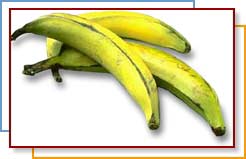Home | FOOD ARTICLES | Food Trivia | Today_in_Food_History | Food_History_Timeline | Recipes | Cooking_Tips | Food_Videos | Food_Quotes | Who’s_Who | Culinary_Schools_&_Tours | Food_Trivia_Quizzes | Food_Poems | Free_Magazines | Food_Festivals_and_Events
Food Articles, News & Features Section
FREE Magazines
and other Publications
Free Professional and Technical Research, White Papers, Case Studies, Magazines, and eBooks
PLANTAINS
This popular banana in Latin American, Caribbean, and Asian countries is often referred to as a cooking banana. Plantains resemble bananas but they are longer in length, thicker skinned, and starchier in flavor. In most countries, plantains are used more like a vegetable than a fruit. They are not suitable for eating raw unless very ripe, when they turn completely black. One half of a large plantain is low in sodium, high in potassium and vitamin A, and a good source of fiber. This versatile fruit has three unique stages when they can be eaten.

Green plantains taste more like a potato with a starchy texture. At this stage, the interior is yellowish or slightly pink. The fruit is firm and is often used as side dishes
Yellow plantains are the middle stage of the fruit. These plantains can have some brownish-black spots. Their role now is both vegetable and fruit and is used in dishes that request for a slightly sweet taste and firm texture.
Black plantains are typically found in sweeter recipes. These plantains are all black or spotty black and are soft. Black plantains can be eaten out of hand.
Availability, Selection, Storage, and Preparation
Plantains are available year round. You can buy plantains at any stage (green, yellow, or black) depending on your use and when you want to enjoy them.
Plantains need to be stored at room temperature. After desired stage of ripeness is reached its okay to refrigerate 2 to 3 days before cooking to slow down the ripen process. As with other bananas, plantains freeze well.
Plantains can be difficult to peel depending on their stage of ripeness. Black plantains are peeled like other bananas. It’s best to use cut the top and bottom of the banana first. Then using the tip of the knife, run the knife along the skin from the top to the bottom of the banana. Repeat this step on all four ridges. Next, carefully peel the skin away from the pulp. The greener the plantain, the thicker the skin; it’s best to peel green plantains under water to minimize bruising.
MAKE PLANTAINS PART OF YOUR 5 A DAY PLAN
* Plantains make a great addition to soups and stews.
* Green plantains are best used like potatoes ? baked or boiled then mashed.
* Also bake ripe plantains to serve with roasted meats.
* Add ripe black plantains in baked desserts like bread.
* Grill yellow plantains! Peel them first and then place on the grill, basting with your favorite marinade.
Plantains Nutrition
Serving size 148g
Amounts Per Serving % Daily Value
Calories 180
Calories from Fat 1
Total Fat 0g 0%
Sodium 0mg 0%
Total Carbohydrate 47g 16%
Dietary Fiber 3g 12%
Sugars 8g
Protein 2g
Vitamin A 35%
Vitamin C 45%
Calcium 0%
Iron 4%
* Percent Daily Values are based on a 2,000 calorie diet.
RELATED ARTICLES
Please feel free to link to any pages of FoodReference.com from your website.
For permission to use any of this content please E-mail: james@foodreference.com
All contents are copyright © 1990 - 2025 James T. Ehler and www.FoodReference.com unless otherwise noted. All rights reserved.
You may copy and use portions of this website for non-commercial, personal use only.
Any other use of these materials without prior written authorization is not very nice and violates the copyright.
Please take the time to request permission.

